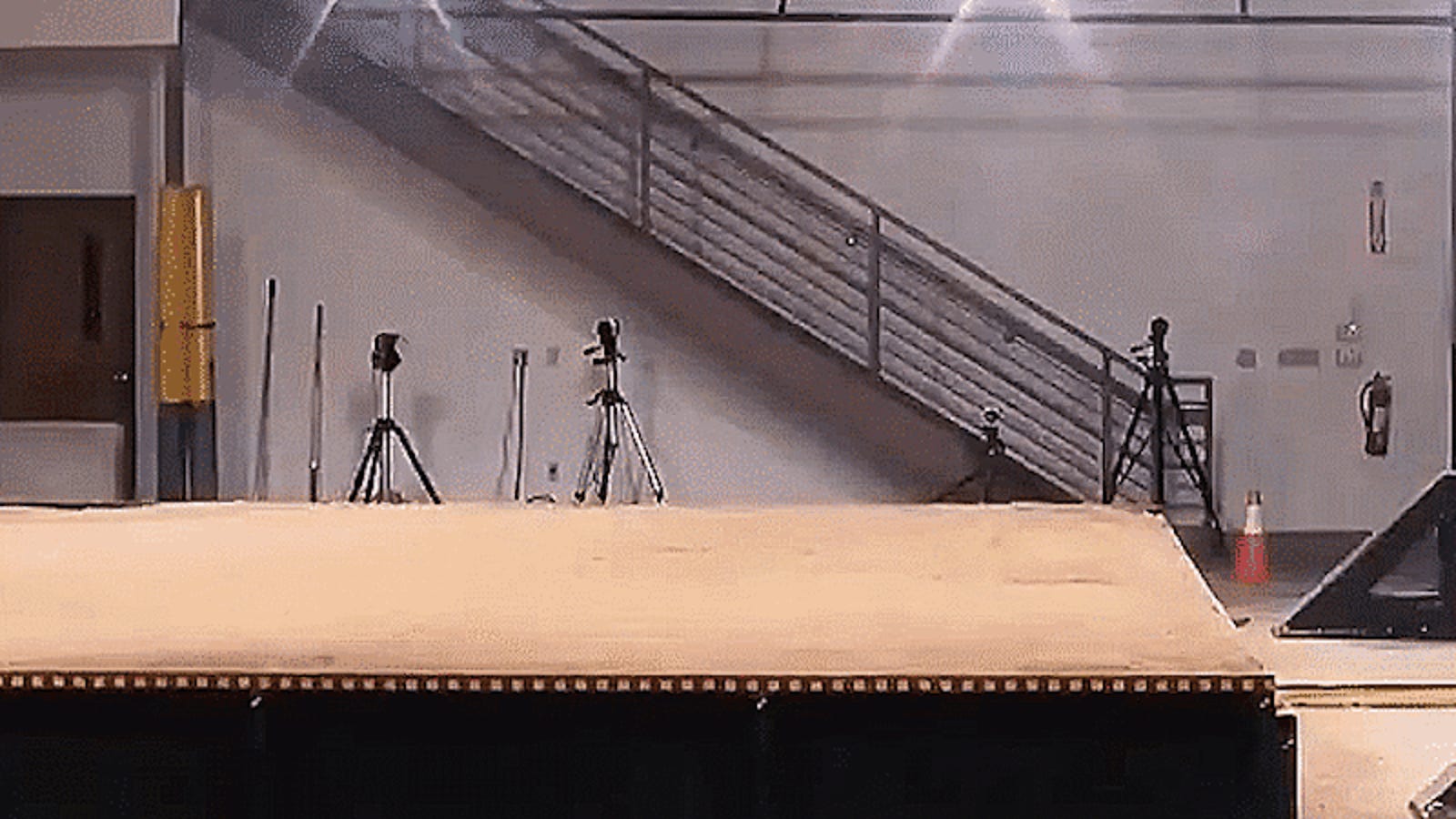The Tesla Model X’s Sand Rollover Test Is Fascinating
https://ift.tt/2ki07HY

Tesla tweeted out a video Sunday morning of its Tesla Model X rolling over after being shoved onto a sandbox by a sled. But even if the tweet read “…the first and only SUV to achieve a NHTSA 5-Star safety rating in every category…” this rollover isn’t the test conducted by the U.S. government, it seems to be a “Soil-Trip” rollover test done internally. Here’s how it works.
My coworkers and I were curious to learn more about this sandbox rollover test after seeing this video Tesla posted on Twitter:
I’ve reached out to Tesla to learn more, but even though they haven’t gotten back to me, a bit of research shows that this is not the government’s rollover test—which I’ll describe in a bit—but rather a “soil trip” test likely meant to simulate what would happen if the Model X left the road and slid sideways onto a soft surface like sand or dirt. (InsideEVs also describes this as an internal test.)
We don’t know how fast Tesla’s tests were conducted, but this 30 mph test of a 2003 Ford Expedition is pretty gnarly:
Such a test isn’t uncommon in the auto industry, with BMW showing off its crash test facility a few years back—a facility that included a sand pit for this very soil-trip test:
In a Siemens research paper on vehicle rollover protection, authors Linstromberg, Scholpp and Sherf describe a typical soil-trip test involving a “flying floor” ramming into energy-absorbing “deformation tubes,” writing:
The soil-trip rollover is a lateral movement of the car into a sand bed. The car is placed on a flying floor and slides laterally into the sand after a sharp deceleration of the sled with deformation tubes.
To describe why such a test is relevant, the report cites a 2003 SAE paper on the importance of various rollover tests in simulating real-world crashes—a paper whose abstract reads, in part:
Rollovers were most commonly induced when the lateral motion of the vehicle was suddenly slowed or stopped. This type of rollover mechanism is referred to as “trip-over”. Trip-overs accounted for 57% of passenger car and 51% of light truck vehicle (LTV) rollovers. More than 90% of trip-overs were initiated by ground contact.
The National Highway Transportation Safety Administration says that, according to its data, 95 percent of “single-vehicle rollovers” are tripped, with the organization including an animation of such a crash on its website, and describing how it occurs:
This happens when a vehicle leaves the roadway and slides sideways, digging its tires into soft soil or striking an object such as a curb or guardrail. The high tripping force applied to the tires in these situations can cause the vehicle to roll over.
So it seems like such a test makes sense if you really want to simulate the most likely real-world rollover conditions. What exactly Tesla is measuring with this test shown in the video, I’m unsure, but a paper written by Nissan Engineers for the Society for Automotive Engineers gives a clue of why an automaker might be conducting such a test.
According to the paper, automakers could use such a test to ensure compliance with Federal Motor Vehicle Safety Standard 226, whose aim it is to reduce occupant ejection from cars during crashes.
Vehicle manufacturers have to define their own test procedures, because FMVSS 226 does not define any rollover test methods.The soil trip rollover test is a vehicle rollover test method in which a vehicle is propelled into a soil pool to measure its rollover characteristics.
So perhaps Tesla is testing out their occupant ejection mitigation tech, here. Or maybe not. Who knows. In either case, this test is very much not what got the Model X its five-star rating from NHTSA, because the feds running markedly different tests to get their rollover star-rating.
You can see the Tesla Model X’s rollover rating above: It’s five stars (thanks to that low-mounted battery pack), making it the only SUV to score top marks in all categories, according to a NHTSA representative. Under the rating, you’ll see a “rollover resistance” of 9.3 percent and a dynamic tip result of “No Tip.”
The tests done to come up with these results are not what’s shown in Tesla’s video. In fact, NHTSA’s “Rollover Resistance” percentage isn’t really the result of a crash test. It stems from something called the “Static Stability Factor,” which is based on two geometric measurements: track width and vehicle center of gravity:
Measuring the track width, T, is fairly straightforward, with the test facility using two “Tire Edge Determination Tools” and a tape measure, with the final result being the average of a bunch of different track width measurements to minimize error.
The center of gravity, H, of the vehicle is a little more complex, requiring the vehicle to be driven or loaded onto a pendulum device like a “Vehicle Inertia Measurement Facility.” Here’s NHTSA’s full description of how this H value is determined:
The platform is connected to a pivot that is above the combined vehicle and platform center-of-gravity height. The platform and vehicle are then tilted in a stable manner by applying known weights at either end of the platform. Detailed error analyses have indicated that this method provides very good results for H measurement?
Once researchers have T and H, that’s all that’s needed to come up with a Static Stability Factory, an “at-rest laboratory measurement” that NHTSA says is an indicator of how top-heavy a vehicle is.
For a while, NHTSA’s rollover rating was based solely on this geometry-based calculation, but in 2004, the feds added the “dynamic tip result” that you see under the Model X’s five-star rating. That came about after Congress asked NHTSA to devise a dynamic test in the “Transportation Recall, Enhancement, Accountability and Documentation (TREAD) Act of November 2000.”
What NHTSA came up with was the “Fishhook” test, which is meant to represent an avoidance maneuver done at speeds up to 50 mph, with The Insurance Institute for Highway Safety describing it in their contemporary press release, saying:
Under the new rating system, a vehicle can improve its score based on static measurements if it successfully undergoes the fishhook maneuver without tipping up on two wheels. Vehicles are tested with a simulated five-passenger load starting at 35 mph and then in 5 mph increments up to a maximum of 50 mph.
Here’s IIHS’s graphic of how the current government rollover test works by including both the static stability factor and the fishhook maneuver:
In any case, while it’s not a government-mandated test but an internal one and while Tesla’s tweet sort of implies that one relates to the other, the Model X inarguably fares pretty well. I’d rather be in that than the Explorer, government test or internal one.
I’ll update this post if Tesla gets back to us on the details of the test.
Tech
via Gizmodo http://gizmodo.com
May 22, 2018 at 12:15PM







blog comments powered by Disqus